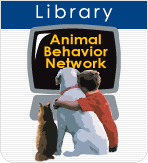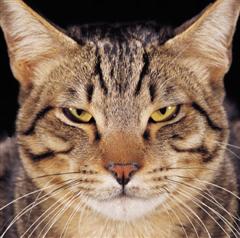|
Need Help?
|
|
Call
1-800-372-3706
to
speak to a Veterinary Behavior Technician |
|
Paws To Speak!
Member Main Menu
|
|

|
 |
|
Help is at your
fingertips by library, email,
and phone. |
Learn more...

Would you like to suggest edits?
Learn More...
|
Feline Stages of Development and
Maturity
For your education...
Feline Adolescence
-
17 weeks
to
1 year
-
Eating solid food.
Change to adult cat food
at 6 - 8 months of age.
Provide food puzzle and
food toys.
-
Sexual maturity - if
not altered
-
Social play lessons.
Continue interactive
play sessions with play
directed to toys not to
human feet or fingers.
-
Seeks social status
by challenging cats in
the household. May
subordinate to larger
adult cats.
-
Spraying may occur -
less likely if altered
or if only cat. Provide
tall posts and praise
cheek marking. Upgrade
to larger litter box -
scooped 2x daily.
-
May get lost. If
allowed outdoors may
wander off, going
farther and for longer
periods of time. Provide
a break-away cat collar
with an ID tag as cat
may not find the way
home.
Feline
Young
Adult -
1 to 6
years
-
Weight gain -
Provide food puzzle and
food toys. Provide
interactive play to burn
calories. Do not
overfeed by providing
only food your cat likes
the best.
-
Social maturity at 2 - 3
years. Personality
strongly affected by
genetics and early
experiences.
-
Social play decreases
- may play more if
living with a cat that
is socially compatible.
Continue interactive
play with food treats to
reward "catching the
prey" toys. Vary the
games every few minutes
to different prey-type
toys and movements.
-
Litter box evaluation.
If cat is spraying or
not using the litter box
every time, read library
topics on feline litter
box training and
inappropriate
elimination. Scoop 2x
daily at a minimum and
add a box with a
sand-based odor free
litter.
-
Cat resources -
Replace scratching posts
and cat beds. Rotate
toys. Add vertical space
with cat tree type
climbers and high
resting areas. Hide
treats in cat play
areas, kennels and beds.
-
Optimal health -
consider well-pet exams
annually or twice a year
to provide a positive
visit to the veterinary
practice and rule out
non-symptomatic
discomfort.
Feline
Older
Adult -
7 years
and older
-
Appetite changes -
Provide food puzzle and
food toys. Do not
overfeed by providing
only food your cat likes
the best. Monitor
weight, food and water
intake. Take cat to the
veterinarian if
increased thirst, weight
gain or loss.
-
Social play decreases
- may play more if
living with a cat that
is socially compatible.
Continue interactive
play with food treats to
reward "catching the
prey" toys. Vary the
games every few minutes
to different prey-type
toys and movements.
-
Increased Vocalization
- may occur if your
cat if feeling some
discomfort or other
stress. Take cat to the
veterinarian for a
comprehensive exam and
diagnostic testing
-
Litter box use. If
cat is spraying or not
using the litter box
every time, read library
topics on feline litter
box training and
inappropriate
elimination. Scoop 2x
daily at a minimum and
add a box with a
sand-based odor free
litter. Take cat to the
veterinarian to evaluate
cognitive disfunction
due to aging.
-
Cat resources -
Provide your cat lots of
comfy beds, tall
scratching posts,
horizontal cardboard
scratching areas, and
protect against weather
that is too hot or too
cold.
-
Behavior changes are
often the first sign of
a physical problem.
Aging cats may require
special diets and
medication prescribed by
a veterinarian to
lengthen life and
quality of life.
American Association of
Feline Practitioners (AAFP)
Feline Behavior Guidelines
2004
|
"Helping you raise a fabulous feline
friend for life." |
|